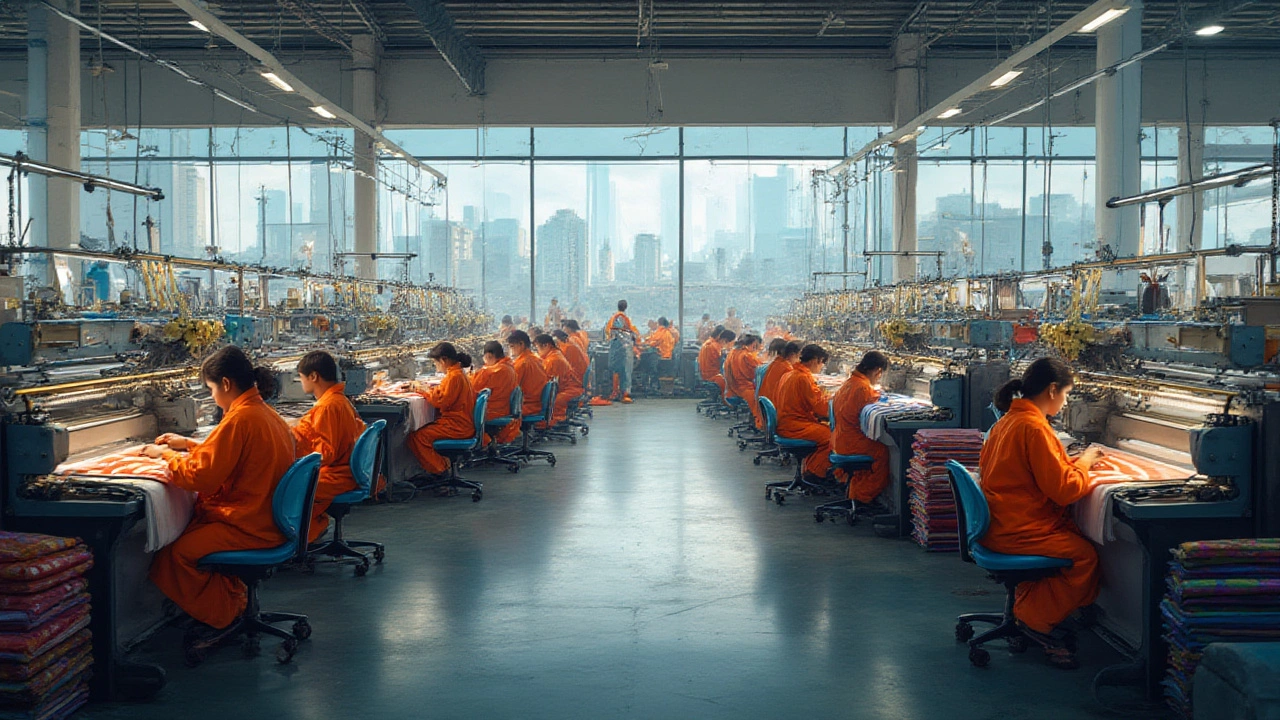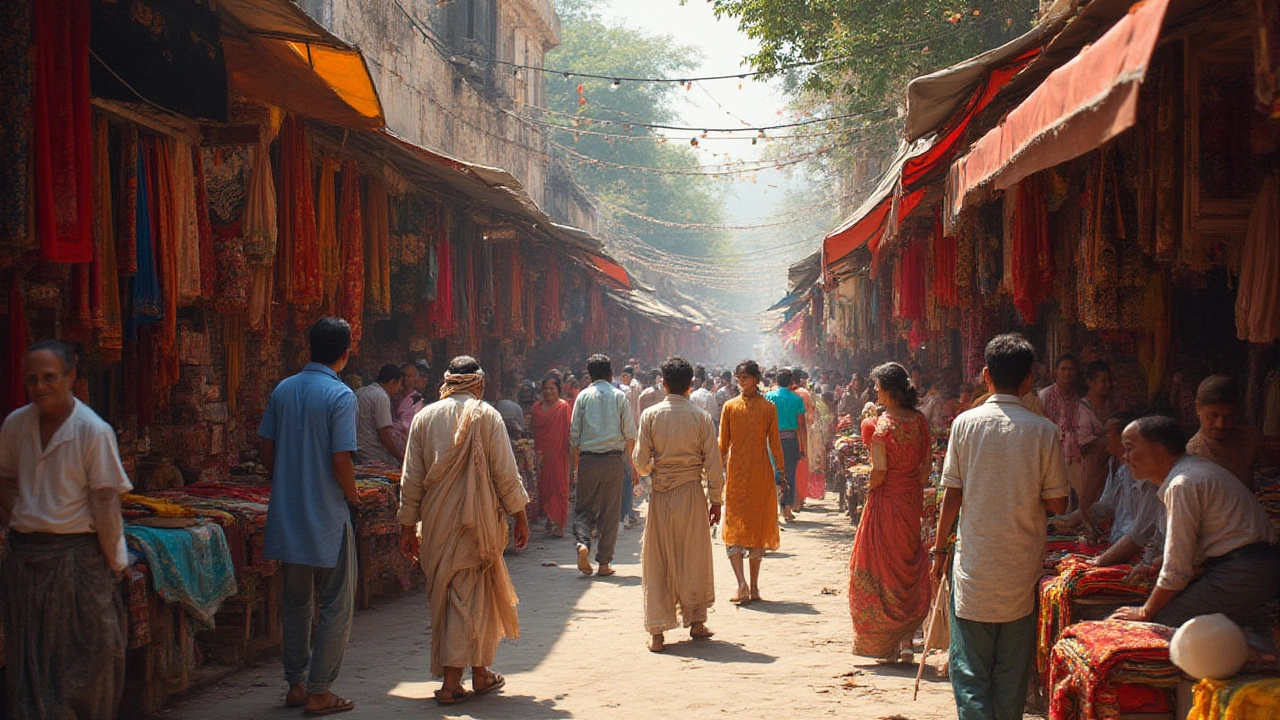Ask any Indian fashion insider, and they'll have one answer on the tip of their tongue: Surat. This buzzing city in Gujarat is not just a dot on the map—it’s woven into the fabric of the Indian textile story, quite literally. Walk through its streets and you’ll see the pulse of the city: giant markets, clattering power looms, vibrant dye houses, and heaps of shimmering saris that seem to go on forever. It’s not nostalgia—Surat ranks as the true 'Textile City of India' and it has no intention of giving up the crown anytime soon. But how did this city earn its textile throne? And what makes it so crucial for the biggest textile ecosystem in the world? Let’s thread this story together.
Surat’s Journey: How It Became India’s Textile Powerhouse
Centuries before Surat’s textile machines began their rhythmic symphony, the city was already in the spotlight for its strategic trade location along the Tapti River. Merchants from Persia, Arabia, and Europe flocked to Surat in the 16th and 17th centuries, making it one of India’s oldest trading ports. Spices and silk rolled out of the city to far-off lands. But it wasn’t until the late 19th and early 20th century, when technical advances and entrepreneurial Gujaratis converged, that Surat truly embraced fabric making on an epic scale.
Flash forward to modern times: Surat now produces a staggering 40 million meters of raw fabric per day—yes, you read that right. According to the Surat Textile Mills Association, over 4.5 million people depend on the industry, making it one of the biggest sources of jobs in western India. Surat’s rise is also tied to the famous 'diamond-polyester' duo—the same family-run outfits who cut and polish the world's diamonds often have stakes in textile factories. It’s a town where business acumen and tradition dance together.
What makes Surat tick as a textile champ? First, it has nearly every part of the fabric-making chain covered: weaving, dyeing, printing, finishing, and trading. Flip through the business section of any Gujarati newspaper and you’ll see ads for new digital textile printers or innovative jacquard looms. Plus, there’s proximity to raw materials—Gujarat is home to big cotton and chemical hubs, so polyester yarn (the city's lifeblood) is almost “local.” And don’t forget the talent: generations of weavers and craftsmen run workshops where everything from basic netting to complex Banarasi lookalikes are crafted at lightning speed. When a new sari style trends on social media, Surat’s mills can whip up hundreds of similar fabrics overnight. That agility is tough to beat.
To put Surat's textile might in perspective, check out this table of fascinating facts:
| Aspect | Surat's Stats |
|---|---|
| Fabric Output | 40 million meters/day |
| Textile Units | Over 650,000 power looms |
| Total Jobs Created | Approx. 4.5 million |
| Share in India's Man-made Fabric | Nearly 80% |
| Textile Market Worth | $3.5 billion (approx.) annually |
If you think all Surat offers is sheer numbers, think again. The city’s production strengths fueled the Indian sari revolution of the 1990s. Chiffon, georgette, crepe—you name it, Surat supplies it. And while you may not spot 'Surat' written on a clothing tag, there’s a good chance any synthetic fabric dress you’ve bought in India, or even the bedspread in your hotel, started its journey here.
What Drives Surat’s Textile Industry? The Real Secret Sauce
What’s behind Surat’s textile slogan? It’s a mash-up of sweat, speed, and a stellar dose of survival instinct. At the core are the power looms—some say there are over 650,000 of them humming around the city, each manned by swift-handed workers, some of whom have spent decades at their craft. The average loom spits out roughly 65-70 meters of fabric each day, from fluid polyester to radiant nylon. This interconnected web of weavers ensures that production rarely pauses, whether it’s midday or midnight.
The supply chain is a wild ride. There’s a legion of processes under Surat’s textile umbrella. Let’s break it down:
- Textile manufacturing: Surat’s factories spin and weave polyester yarn like an orchestra. Each workshop specializes—some do plain fabric, others go all-in on printed saris.
- Dyeing hubs: Massive dye houses line the city’s outskirts, where giant pots bubble with colors. The science here is next-level—newer facilities use computerized dyeing to save water and reduce waste.
- Printing units: If there’s one thing Surat’s famous for, it’s the mind-bending variety of prints. From studio hand-block work to digital laser jobs, anything a designer imagines can be on a bolt of fabric the next day.
- Finishing & packing: Ready bolts are cut, pressed, and bundled, ready to hit shops from Chennai to Chandigarh.
- Market distribution: The Surat Textile Market—over ten hectares of endless shops—deals with billions of rupees every week. Agents hustle to get their hands on the latest trends, as buyers queue up from across the country.
So, what helps Surat keep its edge? Not just cheap labor (though that’s a draw), but a networked, almost “just-in-time” system. For example, if a TV soap popularizes a certain sari pattern, Surat’s power loom owners are usually the first to notice. WhatsApp groups light up, sample pieces get exchanged overnight, and by the weekend, giant markets are flooded with lookalike sarees. This lightning-fast adaptation is Surat’s homegrown superpower—and it’s why small towns in UP, Bihar, or Andhra line up to source from here.
Another trick up Surat’s sleeve is volume discounting. Since everything is produced in bulk, prices stay low, and this keeps the entire supply chain humming. It’s said you can get a basic polyester sari for the price of a restaurant meal—try that anywhere else. Also, technology investment is huge: automated looms, CAD designing, even AI-driven dye matching is now standard in the city’s high-end units.
One more interesting tidbit—while Surat is ground zero for synthetic fabrics, especially polyester, there’s been a steady move toward blended textiles and eco-friendly options too. Workshops are adding organic dyes and recycled yarn to their product lines, partly because younger shoppers are demanding it and partly because of tougher pollution norms. The city’s textile cluster has had to reinvent itself several times—most recently during the COVID-19 pandemic which hit the market hard. Yet, resilience seems coded into the city’s DNA; Surat’s mills bounced back with PPE kits and mask production almost overnight.

The Ripple Effect: Surat’s Role in Indian Textiles and Global Markets
Step into any Indian wedding bazaar, and chances are every third fabrication comes from Surat. You’ll find everything from low-cost daily wear to flamboyant lehengas and even “designer” lookalikes made for Bollywood’s middle-class fans. The numbers back it up: Surat supplies almost 80% of all man-made fabric in India—shocking, but true. That means your favorite shopping malls in Mumbai, Delhi, or even Dubai probably have racks filled with Surat’s polyesters, georgettes, and viscose blends.
Surat’s influence goes far beyond domestic markets. The city is a major exporter, sending millions of meters of fabric to the Middle East, Africa, Sri Lanka, and Southeast Asia each year. Even apparel giants in Europe and the U.S. have begun sourcing basic clears or blended textiles from Surat for their “fast fashion” lines—because nobody does high-volume, quick-turnaround like Surat.
There’s more than export revenues or quantity. Surat’s textile boom has transformed its society and infrastructure. Textile-based prosperity has built new schools, clinics, even swanky malls and residential societies. Street food joints and chai shops flourish near textile markets. The city’s real estate has evolved as textile fortunes dictate, and the colorful, ambitious spirit here is almost infectious.
But prosperity also brings pressure. Pollution, for one, has been a constant battle. Textile dyeing is infamous for water pollution, and Surat has had to step up in recent years. There are now multiple common effluent treatment plants (CETPs) around the city, technology mandates, and growing awareness among mill owners. Local start-ups are working with government agencies to recycle waste and develop greener dyes. Surat’s future as the textile city of India depends on how it takes on these new challenges—cleaner energy, efficient water usage, and better worker conditions. But if there’s one thing this city is known for, it’s solving problems fast—surviving, hustling, and coming up with a ‘Surati solution’ even when things look bleak.
And here’s something useful: if you’re buying fabric in Surat, you’ll feel like a kid in a candy store. Go early for best bargains, never skip a quick snack at a roadside dosa stand, and ask for “surplus”—it’s code for leftover but high-quality export fabric, often half the regular price. Most traders are open to negotiation (especially on bulk orders), but brushing up your Gujarati or at least some common Hindi phrases helps a lot.
Tips for Textile Business and Shopping in Surat
Thinking of starting a textile business based on Surat’s bounty? Or do you want a local’s guide to making the most of the city’s endless textile bazaars? Here’s the stuff you won’t read on glossy blogs but hear from someone whose aunt’s brother actually runs a sari stall here.
- Visit in person if possible. No matter what you see online, the best quality checks happen by touch—surplus markets are full of gems.
- Bargaining is not an art, it’s a game everyone plays. Don’t accept the first quote—sometimes playing hardball can get you almost 20-30% off.
- If you’re a foreign trader or a non-local, try to partner with established agents or brokers. They charge a small commission, but save you time, introduce you to reliable suppliers, and often handle logistics.
- Bulk buying usually gets you best rates, but always clarify payment terms—most deals in the markets run on credit and trust networks.
- If you want to try eco-fabrics, ask for “green” or “organic” lines. Surat’s newer dye houses and select mills stock these, and demand is steadily rising.
- Packaging for shipping? Surat’s got you covered—there are entire lanes of shops specializing in bulk packing, stitched bags, waterproof wrappers, and labeling. Don’t skimp on this step.
- Watch for festival season (especially before Diwali). This is when new collections launch, gift packs are plentiful, and the buzz is at its peak. But peak season means higher prices and crowded markets—if you prefer quieter negotiation, go a couple months before or after the rush.
- And if you can, tour a textile unit or two. Many local factories are happy to show visitors around—watching a power loom at work or seeing a digital printer spin out a pure gold-thread saree is a thrill that beats any YouTube textile documentary.
Surat’s textile legacy is more than numbers or global rankings. It’s stitched into every corner of the city, from the hustle of teenage helpers in crowded shops to the rooftop dye-works with their rainbow racks. Its future? Only brighter, more vibrant, and faster than ever—just like the fabrics that spill out from its busy looms into wardrobes across the world.
